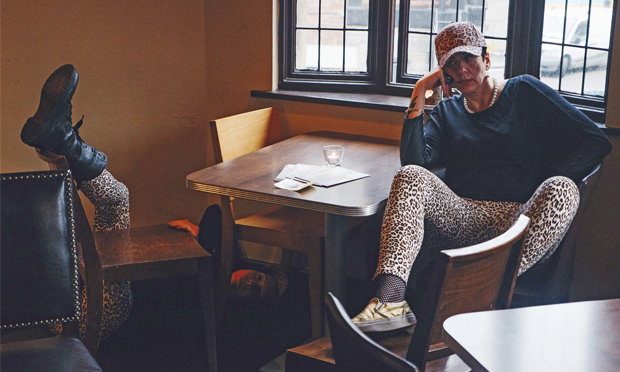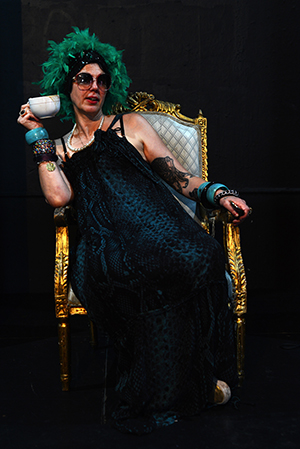Hackney’s older women are the emerging artists you need to be looking out for in 2018

No stereotype: GRACE present a very different image of the aging woman that can be found in almost any other media. Photographs: GRACE
With a collective age of over 150, GRACE’s three founders show that there is no age limit for an emerging artist.
Their forthcoming project How Do I Look?, which will feature ten older female participants from around the world in residence at the canalside Guest Projects space from 6 February, comes at a time when the art world is ripe for the taking by older women artists.
With the recent Turner Prize age limit rise, allowing Lubaina Himid (aged 62) to claim the prestigious honour, writer and art advisor Marta Gnyp has posited that the next trend in the art world will be buying into older women artists.
Tribal scarf loosely tied around grey permed hair, Teresa Albor (one of the aforementioned founders of GRACE) looks at me through her thick-lensed tortoiseshell spectacles.
“It’s a bit of a trend, and we are going to ride that wave”, she admits, but as GRACE’s Manifesto explains, taking on the art world is a small part of a process of demanding “our rightful place in the aesthetic values of our culture, securing and ensuring the recognition that we are exquisite, beguiling and learned”.
Participants on their Arts Council funded program, who identify as‘older and identify as a woman, will practice as what Albor terms “art sleuths”, to examine the representation of older woman in the annals of visual art.
With guidance from GRACE and a range of guest artists and academicians, they will develop work for a magazine-style publication and devise performances to showcase, also at Guest Projects, at a wild cabaret night on Friday 2 March.
 (Guest Projects, off Broadway Market, is an initiative originally conceived by artist Yinka Shonibare MBE in 2008. It offers emerging artists space to experiment, in the way that Shonibare and his peers could as Young British Artists in the London of the late 1980s. Those looking for such artistic refuge are simply required to post an application into the proposal box outside the studio. Yinka and a panel of artists judge these submissions on the merits of the idea, not resale value of the artists.)
(Guest Projects, off Broadway Market, is an initiative originally conceived by artist Yinka Shonibare MBE in 2008. It offers emerging artists space to experiment, in the way that Shonibare and his peers could as Young British Artists in the London of the late 1980s. Those looking for such artistic refuge are simply required to post an application into the proposal box outside the studio. Yinka and a panel of artists judge these submissions on the merits of the idea, not resale value of the artists.)
The relatively open criteria for participants, Albor hopes, will encourage people that may have unexplored or underutilised talent. She explained that she finds “the most open, playful and profound responses to the process have come from participants on the program that have grown up outside of the white middle class art world, and are not restricted by its conditions in the same way”.
What might Hackney’s older women find on the program? “The content is largely about perceptions,” she explains.
“Like when you first saw me, and my grey curly hair, does it make any difference that that’s a wig?” she asks, removing it from her head as casually as a hat.
“I’m wearing a kind of ‘mum’s’ raincoat; would it make any difference if I’m wearing a leather jacket?” She disrobes another layer to reveal just that. “And then if I was actually wearing a leotard,” (another layer is cast aside) “does that change your perspective? What’s going through your mind?”
“If I decided I don’t want to wear trousers,” Albor continues, gracefully pulling them down and off over her boots, “does that change your perspective of who I am as a person? I’m exactly the same person, but how does this affect you? How does that change your perspective of me?”
Deciding that she wants to sweeten her tea, she walks around the café in search of sugar. In her fishnet stockings and leotard, she looks eccentric, yet is so at home in her own body, nobody challenges the bold appearance.
Her long brown hair now flows around her shoulders so perfectly the wig is almost forgotten. She takes some pleasure, I presume, in the power that comes from being profoundly un-stereotypical, but her old lady shopping trolley isn’t to make a statement. It’s practical for the day’s activism and costume.
Sitting back down, Albor sums up: “I’m sure the participants for How Do I Look? are going to range so wildly, that it’s an endorsement of our concept that there is really no stereotype for the older or ageing woman, and yet society has some very narrow stereotypes.”
GRACE’s residency at Guest Projects, How Do I Look?, starts on Tuesday 6 February. If you identify as a woman and identify as older, contact GraceandGraceandGrace@hotmail.com to join the program. Make sure you highlight you are from East London to get one of the spaces reserved for local residents
Alongside the collective, there is a free public program on Thursday nights including; ‘How to Walk’ with Dr MoThrop, a performance based on make-up tutorials called ‘Brush Up’ with Katherine Arieliano and Theresa Albor, and a film screening of Man for a Day. For more details and to reserve free tickets, visit this page on the GRACE website
